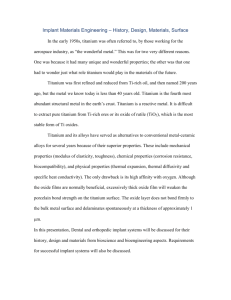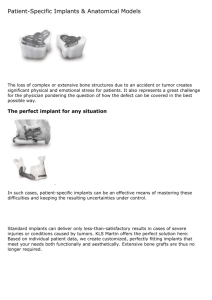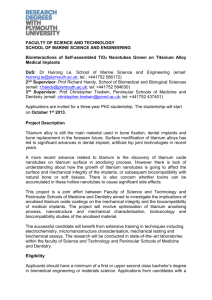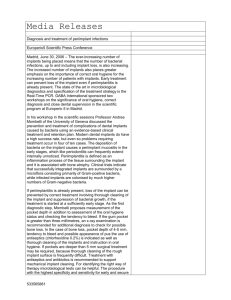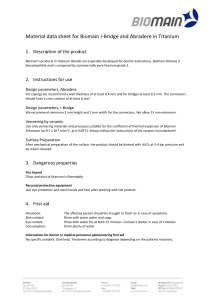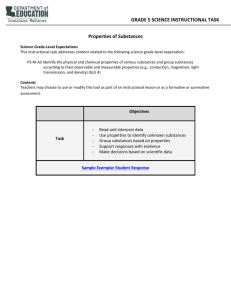mathematical model for estimate the osteogenesis process
advertisement
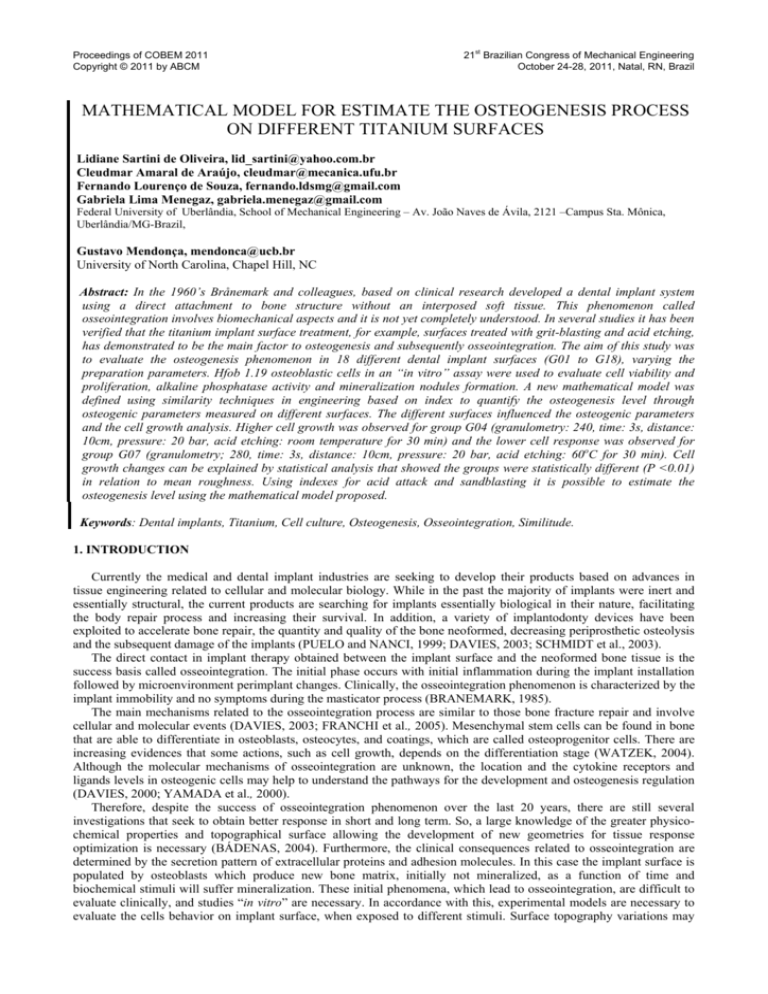
Proceedings of COBEM 2011 Copyright © 2011 by ABCM st 21 Brazilian Congress of Mechanical Engineering October 24-28, 2011, Natal, RN, Brazil MATHEMATICAL MODEL FOR ESTIMATE THE OSTEOGENESIS PROCESS ON DIFFERENT TITANIUM SURFACES Lidiane Sartini de Oliveira, lid_sartini@yahoo.com.br Cleudmar Amaral de Araújo, cleudmar@mecanica.ufu.br Fernando Lourenço de Souza, fernando.ldsmg@gmail.com Gabriela Lima Menegaz, gabriela.menegaz@gmail.com Federal University of Uberlândia, School of Mechanical Engineering – Av. João Naves de Ávila, 2121 –Campus Sta. Mônica, Uberlândia/MG-Brazil, Gustavo Mendonça, mendonca@ucb.br University of North Carolina, Chapel Hill, NC Abstract: In the 1960’s Brånemark and colleagues, based on clinical research developed a dental implant system using a direct attachment to bone structure without an interposed soft tissue. This phenomenon called osseointegration involves biomechanical aspects and it is not yet completely understood. In several studies it has been verified that the titanium implant surface treatment, for example, surfaces treated with grit-blasting and acid etching, has demonstrated to be the main factor to osteogenesis and subsequently osseointegration. The aim of this study was to evaluate the osteogenesis phenomenon in 18 different dental implant surfaces (G01 to G18), varying the preparation parameters. Hfob 1.19 osteoblastic cells in an “in vitro” assay were used to evaluate cell viability and proliferation, alkaline phosphatase activity and mineralization nodules formation. A new mathematical model was defined using similarity techniques in engineering based on index to quantify the osteogenesis level through osteogenic parameters measured on different surfaces. The different surfaces influenced the osteogenic parameters and the cell growth analysis. Higher cell growth was observed for group G04 (granulometry: 240, time: 3s, distance: 10cm, pressure: 20 bar, acid etching: room temperature for 30 min) and the lower cell response was observed for group G07 (granulometry; 280, time: 3s, distance: 10cm, pressure: 20 bar, acid etching: 60oC for 30 min). Cell growth changes can be explained by statistical analysis that showed the groups were statistically different (P <0.01) in relation to mean roughness. Using indexes for acid attack and sandblasting it is possible to estimate the osteogenesis level using the mathematical model proposed. Keywords: Dental implants, Titanium, Cell culture, Osteogenesis, Osseointegration, Similitude. 1. INTRODUCTION Currently the medical and dental implant industries are seeking to develop their products based on advances in tissue engineering related to cellular and molecular biology. While in the past the majority of implants were inert and essentially structural, the current products are searching for implants essentially biological in their nature, facilitating the body repair process and increasing their survival. In addition, a variety of implantodonty devices have been exploited to accelerate bone repair, the quantity and quality of the bone neoformed, decreasing periprosthetic osteolysis and the subsequent damage of the implants (PUELO and NANCI, 1999; DAVIES, 2003; SCHMIDT et al., 2003). The direct contact in implant therapy obtained between the implant surface and the neoformed bone tissue is the success basis called osseointegration. The initial phase occurs with initial inflammation during the implant installation followed by microenvironment perimplant changes. Clinically, the osseointegration phenomenon is characterized by the implant immobility and no symptoms during the masticator process (BRANEMARK, 1985). The main mechanisms related to the osseointegration process are similar to those bone fracture repair and involve cellular and molecular events (DAVIES, 2003; FRANCHI et al., 2005). Mesenchymal stem cells can be found in bone that are able to differentiate in osteoblasts, osteocytes, and coatings, which are called osteoprogenitor cells. There are increasing evidences that some actions, such as cell growth, depends on the differentiation stage (WATZEK, 2004). Although the molecular mechanisms of osseointegration are unknown, the location and the cytokine receptors and ligands levels in osteogenic cells may help to understand the pathways for the development and osteogenesis regulation (DAVIES, 2000; YAMADA et al., 2000). Therefore, despite the success of osseointegration phenomenon over the last 20 years, there are still several investigations that seek to obtain better response in short and long term. So, a large knowledge of the greater physicochemical properties and topographical surface allowing the development of new geometries for tissue response optimization is necessary (BÁDENAS, 2004). Furthermore, the clinical consequences related to osseointegration are determined by the secretion pattern of extracellular proteins and adhesion molecules. In this case the implant surface is populated by osteoblasts which produce new bone matrix, initially not mineralized, as a function of time and biochemical stimuli will suffer mineralization. These initial phenomena, which lead to osseointegration, are difficult to evaluate clinically, and studies “in vitro” are necessary. In accordance with this, experimental models are necessary to evaluate the cells behavior on implant surface, when exposed to different stimuli. Surface topography variations may st Proceedings of COBEM 2011 Copyright © 2011 by ABCM 21 Brazilian Congress of Mechanical Engineering October 24-28, 2011, Natal, RN, Brazil influence the adhesion, proliferation, protein secretion and extracellular matrix mineralization, accelerating the bone repair. Osteoblasts cells respond to implant surface energy and roughness variations. The implant topography changes can influence the osteoblasts and macrophages adhesion and can influence the production and growth factors concentration in the periimplant site (SCHWARTZ e BOYAN, 1994). The collagen synthesis, extracellular matrix, cytokines and growth factors, are favored by the implant surface roughness (ROSA e BELOTI, 2003). Several authors have studied the changes related to implant surface topography using “in vivo” and “in vitro” techniques to determine the osteogenic parameters, such as adhesion, proliferation, cell viability, total protein levels, alkaline phosphatase and mineralization nodules (ROSA e BELOTI, 2003; XAVIER et al., 2003). Cell culture tests are used mainly to get multiplication, function, toxicity and adherence. The goal is to analyze the cell interaction on the surfaces indicating a bioactivity and also the area toxicity. The osteogenesis process is an important effect of osseointegration formation and can be modified through the different surface conditions of the titanium implants. In vitro tests are laborious and expensive, so an alternative formulation using predictive equations is a workaround to get the osteogenesis level. The objective of this work is to develop a mathematical model, using similarity techniques and “in vitro” osteoblastic cell culture tests on titanium surfaces with different roughness and different surface energies to evaluate the osteogenesis effects. 2. MATERIALS AND METHODS The analysis of osteogenic parameters was done through an osteoblastic cell culture test on discs of titanium surfaces modified with different conditions of sandblasting and acid attack. The values of adhesion and proliferation cellular, alkaline phosphatase and mineralization nodules, which were extracted from cell culture tests to form a predictive function for the osteogenesis level were used. Finally, similarity techniques were used to obtain a final equation to newly quantify the osteogenesis as a function of qualifier indices of different titanium surfaces. 2.1 Specimens of Titanium The analysis of cell culture, measurement of roughness and surface energy was made on titanium discs with 6mm of diameter and 2mm of thick, supplied by Neodent Implants Company. Tests in 18 groups with 27 discs each (in total 486 discs) with different surface treatments (sandblasting and acid attack) were prepared. The sandblasting conditions were made varying the size, the sandblasting time, the distance from the jet and the jet pressure on surface. In the acid attack the acid types were varied, the temperature and time of exposure to the acid by the titanium discs. Table 1 shows how the groups were classified to the sandblasting conditions and Table 2 shows the classification related to acid attack conditions. Table 3 shows the surfaces distribution associated with the sandblasting and acid attack. Table 1. Sandblasting used on the surfaces provided by the Neodent Company. Groups (J) Granulometry (m) Time (s) Attack Distance (cm) Pressure (bar) 240µm 3 10 20 1 280µm 3 10 20 2 280µm 4 10 15 3 280µm 3 15 15 4 280µm 4 10 20 5 -----6* 280µm 3 15 20 7 280µm 2 10 30 8 * Without sandblasting (Normal condition only machined) Table 2. Acid attack used on surfaces provided by Neodent Company. Groups (A) Acids Temperature (°C) Time (min) F2 60 30 1 F1 60 30 2 F1 Environment 30 3 F2 Environment 30 4 F3 60 30 5 F3 Environment 30 6 F3 60 60 7 F3 60 120 A8 st Proceedings of COBEM 2011 Copyright © 2011 by ABCM 21 Brazilian Congress of Mechanical Engineering October 24-28, 2011, Natal, RN, Brazil Table 3.Groups of surfaces provided by Neodent Company. Groups1 G01 G02 G03 G04 G05 G06 G07 1 1 1 1 1 1 2 J 1 2 3 4 5 6 1 A G08 G09 G10 G11 G12 G13 G14 G15 G16 G17 G18 2 2 2 3 2 4 2 5 2 6 3 7 4 7 5 7 6 7 7 7 8 7 1: The characteristics of the sandblasting material and the acid type are confidential information from the company participating in this study. 2.2 Cell culture tests In vitro cell culture tests were made with osteoblastic cell lineage under specimen surface. Tests were developed for measuring the cell viability and proliferation, alkaline phosphatase activity and mineralized matrix formation at 1, 7, 14, 21 and 28 days after the onset of cell culture. Figure 1 shows the cell culture at initial time of testing. Figure 1. Cell culture at initial time of “in vitro” tests. The proliferation and cell viability was done applying MTT reagents (Invitrogen Corporation, USA) and acid isopropanol in the mitochondrial cristae, which identify the cell “life” such as observed in violet supernatants shown in Figure 2. Homogenized supernatant Supernatant without homogenization Figure 2. Homogenized supernatant (violet shade) with MTT reagents on the cells after 4 hours of incubation. The alkaline phosphatase activity (ALP) was made using a commercial kit (Sigma, St. Louis, MO, USA) following the manufacturer's instructions at 7, 14 and 21 days of culture. In this same test, the total protein was measured using the Bradford method, BCA protein assay kit (Pierce Biotechnology Inc., Rockford, IL, USA). The mineralization nodules were performed with dye red-orange pigment called Alizarin red S 1% (Sigma, St. Louis, MO, USA) after 28 days of culture. 2.3 – Osteogenisis intensity measurement The bone matrix mineralization process is controlled by collagen and noncollagenous protein matrix and enzymes, especially alkaline phosphatase (ALP) (ROSA e BELOTI, 2003; XAVIER et al., 2003; DECLERCQ et al., 2005). An increase in ALP activity in osteogenic cells culture started the mineralization process and differentiation of these cells in osteoblasts phenotype (DECLERCQ et al., 2005; DAVIES, 2003; ROSA e BELOTI, 2003). Besides alkaline phosphatase, mineralization nodules are also markers of osteoblast differentiation and show a positive correlation with the levels of ALP (ROSA e BELOTI, 2003; XAVIER et al. 2003). Despite providing information about culture state and cell functions, normally the mineralization nodules are analyzed at the end of a culture (Wang et al., 1996). According to the literature (PERIZZOLO; LACEFIELD e BRUNETTE, 2001; CARVALHO, 2005; XAVIER, 2002) the higher values obtained for cell proliferation and viability can be estimated, alkaline phosphatase and mineralization nodules, greater osteogenesis viability and consequently better osseointegration efficiency. Normally, st Proceedings of COBEM 2011 Copyright © 2011 by ABCM 21 Brazilian Congress of Mechanical Engineering October 24-28, 2011, Natal, RN, Brazil osteoblastic cell culture tests can provide these variables. According to this, to simplify the approach to obtain a predictive equation for the phenomenon a new index was defined to quantify osteogenesis intensity considering such variables. To model this intensity, all variables were normalized by a cell number and each variable was weighed according to phenomenon influence. Therefore, osteogenesis levels () were defined as follows: Ψ η ρ η ρ (1) η ρ Where: i : Normalized variables obtained by “in vitro” experiment, cell proliferation and viability (2), alkaline phosphatase (1) and mineralization nodules (3); i : Relative weighed for variable influence. In equation 1, the η values are getting using cell culture tests. η variable was linked with alkaline phosphatase, η variable was linked with cell proliferation and viability and finally η variable was linked with mineralization nodules. The relative weighed i are defined to according your importance level on osteogenesis process. In according to literature, the cell proliferation and viability follows to alkaline phosphatase for better osteogenesis are that more important factors. The relative weights adopted were 0.50 for alkaline phosphatase, from 0.30 for cell proliferation and viability and 0.20 for mineralization nodules. Using this weights and Eq. (1) it’s possible to estimate the specific osteogenesis degree for each test, i.e.: Ψ η 0,50 η 0,30 η 0,20 (2) In Equation (2) it can be observed that for the same cell quantity measured in different variables, the alkaline phosphatase activity measured and cell proliferation and viability responding together 80% efficiency in generation effect of viable bone cells. The osteogenesis measurement was defined by equation (2). The final mathematical equation will be obtained by the similarity theory, which allows the determination of a prediction function using influential variables as a basis for experimental validation. The Buckingham criterion (GLENN MURPHY, 1950) to determine the final prediction function was used. Using this procedure it can be possible to obtain a mathematical function expressed in terms of dimensional parameters and correlate function expressed in terms of dimensionless parameters representing the osteogenesis level in accordance with “in vitro” experiments cell culture. The sensitivity analysis of each variable is made varying one parameter and keeping all others as constant. To estimate osteogenesis predictive function, it is necessary to consider the influence of all variables, i.e.: π ,π ,π ,…,π π (3) Where: 1 : Variable measurement; i : Influence variables. Supposing a problem consists of two influence variables combined by function product it is possible to show that: π ,π . π ,π π ,π π ,π (4) The parameter bar indicates pre-defined constants. To evaluate the correlation functions degree as a combination of product function it is necessary to make a “test validation”. It is done assuming that Eq. (4) is also valid for a new dataset, i.e., for another 2 value, or a new 3 dataset. Thus: π ,π π ,π π ,π π ,π (5) Therefore, if Eq. (5) is satisfied, the final predictive equation can be combined by a function product. The predictive equation was defined by two dimensionless indexes (J, A) characterized by sandblasting conditions and acid attack. So: st Proceedings of COBEM 2011 Copyright © 2011 by ABCM 21 Brazilian Congress of Mechanical Engineering October 24-28, 2011, Natal, RN, Brazil J J, A: 1,2...,8 (6) According to that, osteogenesis levels values were determined using “in vitro” experiments for all groups, shown in Tables 1, 2 and 3. 3. RESULTS Osteogenesis indexes were calculated through data of cell culture tests and equation (2) and are shown in fig. 3. In this case a reference value A ( ) of 7 is used. Similarly, the figures 4 and 5 show the osteogenesis values using as reference value ( , ) of 1 and 2, respectively. Figures 3 to 5 show the curve fitting, 0,0008256 0,01386 2,442 , , , 0,423 0,5085 2,033 (R2 = 0,96) (R2 = 0,97) (R2 = 0,96) (7) Figure 3 – Values of x for fixed . Figure 4 – Values of x for fixed . st Proceedings of COBEM 2011 Copyright © 2011 by ABCM 21 Brazilian Congress of Mechanical Engineering October 24-28, 2011, Natal, RN, Brazil Figure 5 – Values of x for a new fixed . According to component equations (Eq.7), the fixed terms are, F π ,π 0,7925 (8) F π ,π 0,6153 (9) Through resultant equations and using a product function we have, Ψ 1,44 , , 5,29 , 7,38 , 0,27 (10) In a sequence, we can validate the predictive equations using a new fixed value J ( =2). Figure 6 shows curves for two data sets to visualize the measurement error. A good agreement note with 11% relative error is possible. So, we can account the predictive equation (Eq. 10) for measuring the osteogenesis indexes over nonlinearity phenomenon under validate between 1 J 7 e 1 A 7. Right side Left side Figures 6– Predictive equation curves for validate testing. Therefore, the osteogenesis index is estimated with J and A combinations different from and compared to a standard value. In this case, the default value would be appropriate to the surface normally used in standard dental implants. Since this condition is unknown, in this paper the surface standard condition was defined as the maximum osteogenesis level for A and J equal 7. Using Eq. 10 a standard osteogenesis value ( = 1) was obtained, used as a standard reference for comparison with other surface conditions and this case it is represented by, Granulometry : 280 m Jet time: 2 s Proceedings of COBEM 2011 Copyright © 2011 by ABCM st 21 Brazilian Congress of Mechanical Engineering October 24-28, 2011, Natal, RN, Brazil Jet distance: 10 cm Jet Pressure: 30 bar Acid: F3 Acid temperature: 60 ˚C Acid time attack: 1h Using track validated parameters our results show that jet pressure is more important than abrasive granulometry, jet time and jet distance. Additionally a 60 ˚C temperature and a F3 longer acid exposition are the more influential surface factors for optimal osteogenesis values. 4. DISCUSSION The osteoblastics cells are sensitive depending on surface topography of the implant (ZINGER et al., 2003). In general, the cells cultured on rough surfaces had morphological characteristics of osteoblasts in a more differentiated and secrete larger amounts of alkaline phosphatase (DE OLIVEIRA e NANCI, 2004). Porosity variations and surface roughness of titanium influence cellular metabolism and release of cytokines and growth factors, such as osteoblasts (BOYAN et al., 2003; RICE et al., 2003). Surface treatments to modify the titanium topography and the chemical characteristics are known. Several studies have shown that these changes may affect not only the surface properties such as the cellular response to that surface, and the surface roughness can have an effect even larger than the actual chemical composition (ROSA e BELOTI, 2003; SCHMIDT et al., 2003; XAVIER et al., 2003). In recent studies, roughness surfaces have shown a positive effect on osteoblast differentiations which contribute to bone formation (BOYAN et al., 2003). In addition, roughness surfaces also help the collagen synthesis, ALP activity, growth factors and cytokines, eg, prostaglandins (ROSA and BELOTI, 2003). It is valid to emphasize that microstructured surfaces reduce adhesion and cell proliferation (BOYAN et al., 2003; ROSA e BELOTI, 2003). However, it is important to consider that there are discrepancies between the results reported by several studies on mineralization that may be caused by the difference in method and type of cell culture (XAVIER et al., 2003). The cells were cultured on different titanium surfaces in order to evaluate the osteogenesis process. These culture processes, cells obtained from human, laboratory research closer to clinical practice, and has been widely appreciated in the literature in an attempt to unravel the cellular and molecular events that regulate osseointegration. The analysis results in vitro were used to mathematically model the phenomenon, considering the analysis variables, different surface qualities using a different process with different acid attack and sandblasting conditions. It is known that the surface characteristics of dental implants made of titanium when in contact with blood, originated from the implantation surgery, work like a chemical receptor and enable interactions and important cellular modifications. Currently, the way to evaluate the intensity of this phenomenon is by “in vitro” testing or by clinical research in humans or animals. In the last cases, such studies are evaluative in nature or macro, where for example, they compare removal torques. Therefore, a direct analysis of the osteogenesis process is complicated and relatively expensive. In 1995, Martin et al. analyzed titanium discs grade II with different sandblasting surfaces with thick grain, acid attack (HCl and H2SO4) and coated with plasma titanium hydride. The authors analyzed the osteogenic parameters on surface of titanium discs and in their analysis they observed that when compared with cells culture on plastic control, the number of cells was reduced on the surfaces attacked, and increasing on coated surfaces, while the number of cells on the other surfaces was equivalent to those observed on the plastic control group. Regarding the activity of alkaline phosphatase, isolated cells were found with a trend to decrease when rough surfaces increase. Optimum value for osteogenesis calculated was the G04 group. In this group the discs were blasted with a 240 m size particle by 3s time with 10 cm jet distance of 10 cm and 20 bar pressure (A2 acid at room temperature for a 30 min period). In these conditions, with particle size and acid temperature exception, the G07 group showed the lowest level of osteogenesis. Biocompatibility of bone tissue between the implant surface and the local environmental factors assume important roles in the process of healing. Mailhot and Borke (1998) presented a convenient method of isolation and culture in vitro osteoblastic cells using intra-oral human-derived preparations for the local site of a dental implant. The authors characterized the phosphatase, the presence of osteonectin, osteocalcin and an intracellular precursor of collagen type I. In the final analysis, type I collagen was higher than 90% of the protein of bone matrix and also noted that all cultures tested, showed areas of calcification of various degrees. In this study, the maximum value of ALP was for the G04 group (10.52 mM / mg protein / min) at 14 days of culture. During this same period, there was a greater proliferation of this group G04 (14,815 cells). On the other hand, the group that showed a bigger area for the mineralization nodules was the G11 group (24.29 mm2) after 28 days of culture. Proceedings of COBEM 2011 Copyright © 2011 by ABCM st 21 Brazilian Congress of Mechanical Engineering October 24-28, 2011, Natal, RN, Brazil 5. CONCLUSION In this work osteogenesis parameters suffered influence by surface conditions. In this case, the ALP maximum value was found in the G04 group (1 = 10,52 µM/ µg protein/min) whereas ALP in 14 days. During this same period, was observed a greater proliferation to Group G04 (2 = 14.815 cells). On the other hand, group 11 showed a greater number of mineralization nodules (3 = 24,29 mm2) after 28 days of cell culture. Using the predictive equation it is possible to estimate the osteogenesis degree of a new titanium surface, within specific bands of sandblasting and acid attack, avoiding “in vitro” and “in vivo” tests which, in general, are longer and costly. 6. ACKNOWLEDGEMENTS The authors gratefully acknowledge the financial support of the funding agencies (FAPEMIG, CNPq and CAPES) and the support of the FEMEC / UFU, LPM / UFU, Biomol / UFU and the Company Neodent Osteointegráveis Implants. 7. REFERENCES ASSIS, A. F.; BELOTI, M. M.; CRIPPA, G. E.; OLIVEIRA, P. T.; MORRA, M.; ROSA, A. L. “Development of the Osteoblastic Phenotype in Human Alveolar Bone-Derived Cells Grown on a Collagen Type I-Coated Titanium Surface”, Clinical Oral Implants Research, v. 20, n. 3, p. 240 – 246, 2009. BÁDENAS, C. J. A. “Tratamientos de Superfície sore Titanio Comercialmente Puro para La Mejora de la Osteointegración de los Implantes Dentales”, 2004, 417f., Tese de Doutorado – Universitat Politècnica de Catalunya, Barcelona – Espanha. BAIER, R. E.; MEYER, A. E. “Implant Surface Preparation”, The International Journal of Oral & Maxillofacial Implants. v. 3, n. 1, p. 9-20, 1988. BELOTI, M. M.; ROSA, A. L. “Osteoblast Differentiation of Human Bone Cells Under Continuous and Discontinuous Treatment with Dexamethasone”, Brazilian Dental Journal, v. 16, n. 2, p. 156-161, 2005. BOYAN, B. D; DEAN, D. D.; LOHMANN, C. H.; COCHRAN, D. L.; SYLVIA, V. L.; SCHWARTZ, Z. “The Titanium Bone-Cell Interface In Vitro: The Role of the Surface in Promoting Osseointegration”, Titanium in Medicine: Material Science, Surface Science, Engineering, Biological Responses and Medical Applications, Eds. BRUNETTE, D. M.; TENGVALL, P.; TEXTOR, M.; THOMSEN, P. Springer Verlag. Berlin, p. 561- 586, 2001. BOWERS, K. T.; KELLER, J. C.; RANDOLPH, B. A.; WICK, D. G.; MICHAELS, C. M. “Optimization of Surface Micromorphology for Enhanced Osteoblast Responses In Vitro”, The International Journal of Oral & Maxillofacial Implants, v. 7, n. 3, p. 302- 310, 1992. BRÅNEMARK, P. I. 1985. “Introduction to Osseointegration: Tissue-Integrated Prostheses”, Quintessence: Chicago Publ. Co. BRÅNEMARK, P. I.; ZARB, G. A.; ALBRETSSON, T., “Prosthèses Ostèointègrèes”, Paris. CdP, 1988: TissueIntegrated Prostheses. Osseointegration in Clinical Dentistry. Chicago: Quintessence Books, 1985. BUSER, D.; SCHENK, R. K.; STEINEMANN, S.; FIORELLINI, J. P.; FOX, C. H.; STICH, H. “Influence of Surface Characteristics on Bone Integration of Titanium Implants. A Histomorphometric Study in Miniature Pigs”, Journal of Biomedical Materials Research, v. 25, n. 7, p. 889-902, 1991. BUSER, D.; NYDEGGER, T.; OXLAND, T.; COCHRAN, D. L.; SCHENK, R. K.; HIRT, H. P.; SNÉTIVY, D.; NOLTE, L. P., “Influence of Surface Characteristics on the Interface Shear Strength Between Titanium Implants and Bone. A Biomechanical Study in the Maxila of Miniature Pigs”, Journal of Biomedical Materials Research, v. 45, n. 2, p. 75-83, 1999. BUSER, D. “Titanium for Dental Applications (II): Implant with Roughened Surfaces”,Titanium in Medicine: Material Science, Surface Science, Engineering, Biological Responses and Medical Applications, Eds. BRUNETTE, D. M.; TENGVALL, P.; TEXTOR, M.; THOMSEN, P. Springer Verlag. Berlin, p. 875-885, 2001. DAVIES, J. E. 2000. 656 p. “Bone Enginnering”, Toronto: em squared Inc. DAVIES, J. E., “Understanding peri-implant endosseous healing” Journal of Dental Education, v. 67, n. 8, p. 932-947, 2003. FÖRCH, R.; SCHÖNHERR, H.; JENKINS, A. T. A., “Surface Design: Applications in Bioscience and Nanotechnology”, Wiley, V. C. H., 2009, 511 p. ISBN: 3527407898 FRANCHI, M.; FINI, M.; MARTINI, D.; ORSINI, E.; LEONARDI, L.; RUGGERI, A.; GIAVARESI, G.; OTTANI, V. “Biological Fixation of Endosseous Implants”, Micron, v. 36, n. 7, p. 665-671, 2005. GOMI, K.; DAVIES, J. E., “Guided Bone Tissue Elaboration by Osteogenic Cells In Vitro”, Journal of Biomedical Materials Research, v. 27; n. 4; p. 429-431, 1993. HACKING, S.; ADAN, M.; BOBYN, J. D.; TANZER, M. M. D.; KRYGIER, J. J., “The Osseous Response to Corundum Blasted Implant Surfaces in a Canine Hip Model”, Clinical Orthopaedics & Related Research: Section II: Original Articles: Research, v. 364, p. 240-253, 1999. Proceedings of COBEM 2011 Copyright © 2011 by ABCM st 21 Brazilian Congress of Mechanical Engineering October 24-28, 2011, Natal, RN, Brazil LINCKS, J.; BOYAN, B. D.; BLANCHARD, C. R.; LOHMANN, C. H.; LIU, Y.; COCHRAN, D. L.; DEAN, D. D.; SCHWARTZ, Z., “Response of MG-63 Osteoblast-like Cells to Titanium and Titanium Alloy is Dependent on Surface Roughness and Composition” Biomaterials, v. 19, n. 23, p. 2219-2232, 1998. LUTHY, H.; STRUB, J. R.; SCHARER, P. “Analysis of Plasma Flame-Sprayed Coatings on Endosseous Oral Titanium Implants Exfoliated in Man: Preliminary Results”, The International Journal of Oral & Maxillofacial Implants, v. 2, n. 4, p. 197-202, 1987. MAILHOT, J. M.; BORKE, J. L., “An Isolation an in Vitro Culturing Method for Human Intraoral Bone Cells Derived from Dental Implant Preparation Sites”, Clinical Oral Implants Research, v. 9, n. 1, p. 43-50, 1998. MALASPINA, T. S. S.; ZAMBUZZI, W. F.; SANTOS, C. X.; CAMPANELLI, A. P.; LAURINHO, F. R. M.; SOGAYAR, M. C.; GRANJEIRO, J. M., “A Possible Mechanism of Low Molecular Weight Protein Tyrosine Phosphatase (LMW – PTP) Activity Modulation by Glutathione Action During Human Osteoblast Differentiation”, Archives of Oral Biology,v. 54, n. 7, p. 642-650, 2009. MARTIN, J. Y.; SCHWARTZ, Z.; HUMMERT, T. W.; SCHRAUB, D. M.; SIMPSON, J.; LANKFORD, J. JR.; DEAN, D. D.; COCHRAN, D. L.; BOYAN, B. D., “Effect of Titanium Surface Roughness on Proliferation, Differentiation, and Protein Synthesis of Human Osteoblast-like Cells (MG-63)”, Journal of Biomedical Materials Research, v. 29, n. 3, p. 389-401, 1995. MASUDA, T.; SALVI, G.; OFFENBACHER, S.; FELTON, D.; COOPER, L., “Cell and Matrix Reactions at Titanium Implants in Surgically Prepared Rat Tibiae”, The International Journal of Oral & Maxillofacial Implants, v. 12, n. 4, p. 473-485, 1997. MEFFERT, R. M.; BLOCK, M. S.; KENT, J. N., “What is Osseointegration?”, The International Journal of Periodontics & Restorative Dentistry, v. 7, n. 4, p. 9 – 21, 1987. MICHAELS, C. M.; KELLER, J. C.; STANFORD, C. M.; SOLURSH, M.; MACKENZLE, I. C., “In Vitro Connective Tissue Cell Attachment to Cp Ti”, Journal of Dental Research, v. 68, p. 276, 1989. OURA, K.; LIFSHITS, V. G.; SARANIN, A. A.; ZOTOV, A. V.; KATAYAMA, M., “Surface Science: An Indroduction”, Springer-Verlag, Berlin, 2003. 440 p. PIATTELLI, A.; CORIGLIANO, M.; SCARANO, A.; COSTIGLIOLA, G.; PAOLANTONIO, M., “Immediate Loading of Titanium Plasma-Sprayed Implants: An Histologic Analysis in Monkeys”, Journal of Periodontology, v. 69, n. 3, p. 321-327, 1998. PUELO, D. A.; NANCI, A., “Understanding and Controlling the Bone-Implant Interface”, Biomaterials, v. 20, n. 23, p. 2311-2321, 1999. ROSA, A. L.; BELOTI, M. M., “Effect of cpTi Surface Roughness on Human Bone Marrow Cell Attachment, Proliferation, and Differentiation”, Brazilian Dental Journal, v. 14, n. 1, p. 16-21, 2003. SCHMIDT, C.; STEINBACH, G.; DECKING, R.; CLAES, L. E.; IGNATIUS, A. A. , “IL-6 and PGE2 Release by Human Osteoblasts on Implant Materials”, Biomaterials, v. 24, n. 23, p. 4191 – 4196, 2003. SCHRADER, M. E.; LOEB, G. I. 1992, 484 p., “Modern Approaches to Wettability. Theory and Applications”, New York: Plenum Press., ISBN 0306439859. SCHWARTZ, Z.; BOYAN, B. D., “Underlying Mechanisms at the Bone-Biomaterial Interface”, Journal of Cellular Biochemistry, v. 56, n. 3, p. 340-347, 1994. UITTO, V.J.; LARJAVA, H.; PELTONEN, J.; BRUNETTE, D.M., “Expression of Fibronectin and Integrins in Cultured Periodontal Ligament Epithelial Cells”, Journal of Dental Research, v. 71, n. 5, p.1203-1211, 1992. VIDIGAL JUNIOR, G. M.; GROISMAN, M., “Osseointegração x Biointegração: Uma Análise Crítica”, Revista Brasileira de Odontologia, v. 4, p. 54, 1997. XAVIER, S. P.; CARVALHO, P. S. P.; BELOTI, M. M.; ROSA, A. L., “Response of Rat Bone Marrow Cells to Commercially Pure Titanium Submitted to Different Surface Treatments”, Journal of Dentistry, v. 31, n. 3, p. 173180, 2003. WATZEK, G. 2004, 181 p., “Implants in Qualitatively compromised bone”, Quintessence Publishing Co, Inc. São Paulo. WENNERBEG, A.; HALLGREN, C.; JOHANSSON, C.; DANELLI, S. A., “Histomorphometric Evaluation of ScrewShaped Implants Each Prepared with two Surface Roughnesses”, Clinical Oral Implants Research, v. 9, n. 1, p. 1119, 1998. YAMADA, M.; TANAKA-DOUZONO, M.; WAKIMOTO, N.; HATAKE, K.; HAYASAWA, H.; MOTOYOSHI, K. “Effect of Cytokines on the Proliferation/Differentiation of Stroma-Initiating Cells”, Journal of Cellular Physiology, v. 184, n. 3, p. 351-355, 2000.

